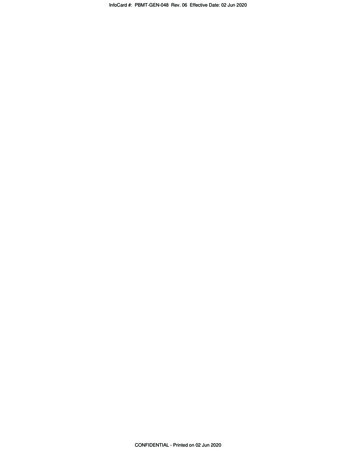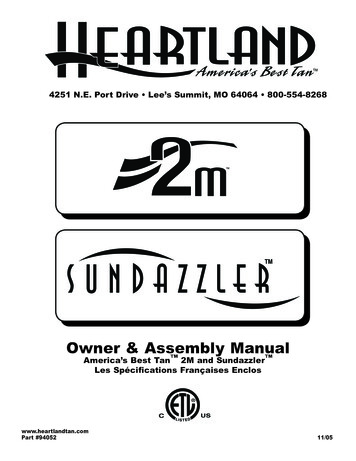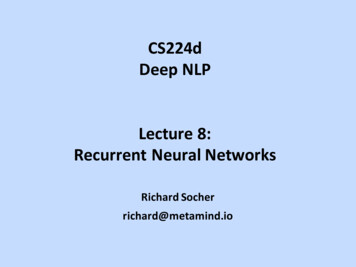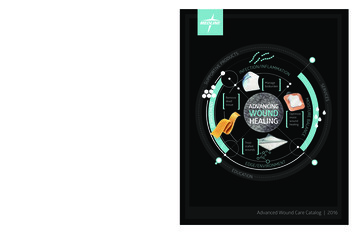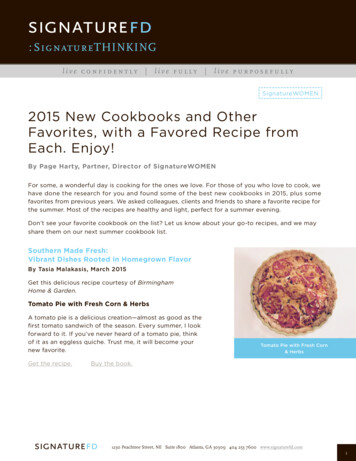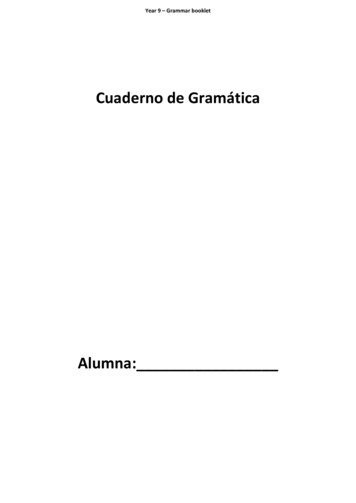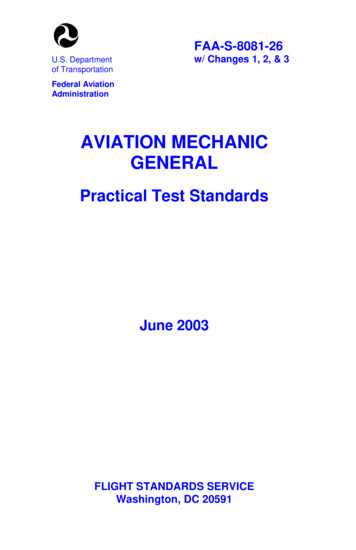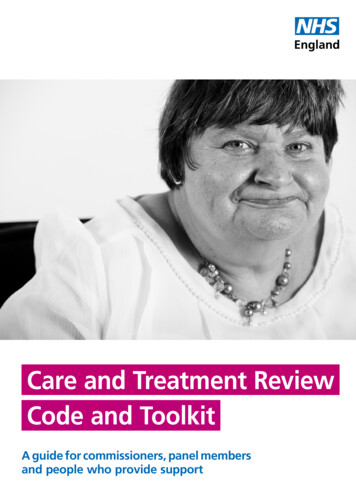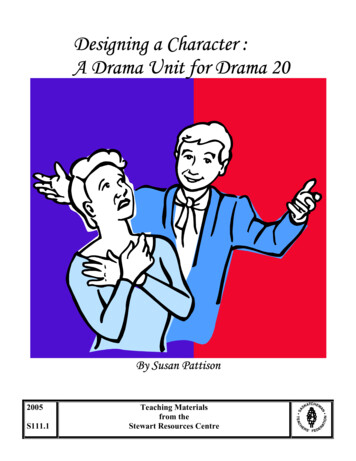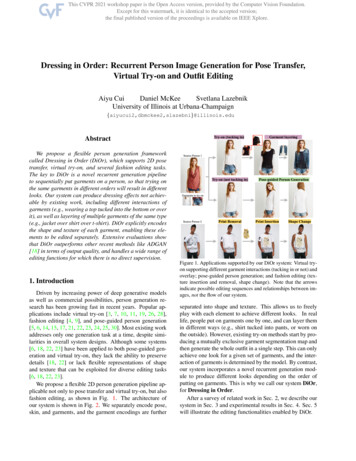
Transcription
Dressing in Order: Recurrent Person Image Generation for Pose Transfer,Virtual Try-on and Outfit EditingAiyu CuiDaniel McKeeSvetlana LazebnikUniversity of Illinois at ois.eduAbstractWe propose a flexible person generation frameworkcalled Dressing in Order (DiOr), which supports 2D posetransfer, virtual try-on, and several fashion editing tasks.The key to DiOr is a novel recurrent generation pipelineto sequentially put garments on a person, so that trying onthe same garments in different orders will result in differentlooks. Our system can produce dressing effects not achievable by existing work, including different interactions ofgarments (e.g., wearing a top tucked into the bottom or overit), as well as layering of multiple garments of the same type(e.g., jacket over shirt over t-shirt). DiOr explicitly encodesthe shape and texture of each garment, enabling these elements to be edited separately. Extensive evaluations showthat DiOr outperforms other recent methods like ADGAN[18] in terms of output quality, and handles a wide range ofediting functions for which there is no direct supervision.1. IntroductionDriven by increasing power of deep generative modelsas well as commercial possibilities, person generation research has been growing fast in recent years. Popular applications include virtual try-on [3, 7, 10, 11, 19, 26, 28],fashion editing [4, 9], and pose-guided person generation[5, 6, 14, 15, 17, 21, 22, 23, 24, 25, 30]. Most existing workaddresses only one generation task at a time, despite similarities in overall system designs. Although some systems[6, 18, 22, 23] have been applied to both pose-guided generation and virtual try-on, they lack the ability to preservedetails [18, 22] or lack flexible representations of shapeand texture that can be exploited for diverse editing tasks[6, 18, 22, 23].We propose a flexible 2D person generation pipeline applicable not only to pose transfer and virtual try-on, but alsofashion editing, as shown in Fig. 1. The architecture ofour system is shown in Fig. 2. We separately encode pose,skin, and garments, and the garment encodings are furtherFigure 1. Applications supported by our DiOr system: Virtual tryon supporting different garment interactions (tucking in or not) andoverlay; pose-guided person generation; and fashion editing (texture insertion and removal, shape change). Note that the arrowsindicate possible editing sequences and relationships between images, not the flow of our system.separated into shape and texture. This allows us to freelyplay with each element to achieve different looks. In reallife, people put on garments one by one, and can layer themin different ways (e.g., shirt tucked into pants, or worn onthe outside). However, existing try-on methods start by producing a mutually exclusive garment segmentation map andthen generate the whole outfit in a single step. This can onlyachieve one look for a given set of garments, and the interaction of garments is determined by the model. By contrast,our system incorporates a novel recurrent generation module to produce different looks depending on the order ofputting on garments. This is why we call our system DiOr,for Dressing in Order.After a survey of related work in Sec. 2, we describe oursystem in Sec. 3 and experimental results in Sec. 4. Sec. 5will illustrate the editing functionalities enabled by DiOr.
source person Isgarment 1garment 2garment 3garment 4garment 5.Segment EncoderFlow Fieldtarget pose Pt(Fig. 3-a)EposeZpose(Fig. 3-b)fsEbodyTbodyGbodyGdecBody Encoder(Fig. 3-c)fg1fg2EsegTg1GskinGgarZbody (Z0)(SPADE Gdec.Figure 2. DiOr generation pipeline (see Section 3 for details). We represent a person as a (pose, body, {garments}) tuple. Generationstarts by encoding the target pose as Zpose and the source body as texture map Tbody . Then the body is generated as Zbody by the generatormodule Gbody . Zbody serves as Z0 for the recurrent garment generator Ggar , which receives the garments in order, each encoded by a 2Dtexture feature map Tgk and soft shape mask Mgk . In addition to masked source images, the body and garment encoders take in estimatedflow fields f to warp the sources to the target pose. We can decode at any step to get an output showing the garments put on so far.2. Related WorkVirtual try-on is to generate images of a given person witha desired garment. The simplest methods are aimed at replacing a single garment with a new one [3, 6, 7, 10, 11, 12,26, 28]. Our work is closer to methods that attempt to modelall the garments worn by a person simultaneously to achievemultiple garment try-on [18, 19, 20, 23]. However, all abovemethods assume a pre-defined set of garment classes (e.g.,tops, pants, etc.) and allow at most one garment in eachclass. This precludes the ability to layer garments from thesame class (e.g., one top over another). Instead, our recurrent design lifts the one garment per class constraint andenables layering. Plus, in all previous work, when thereis overlap between two garments (e.g. top and bottom), itis the model to decide the interaction of the two garments,(e.g., whether a top is tucked into the bottom). By contrast,ours produces different looks for different dressing orders.Pose transfer requires changing the pose of a given person.Several of the virtual try-on methods above [6, 18, 20, 22,23] are explicitly conditioned on pose, making them suitable for pose transfer. Our method is of this kind. Mostrelevant to us are pose transfer methods that represent posesusing 2D keypoints [5, 6, 17, 21, 24, 25, 30]. GFLA [21]computes dense 2D flow fields to align source and targetposes. We adopt GFLA’s global flow component as part ofour system, obtaining comparable results on pose transferwhile adding a number of try-on and editing functions.Fashion editing. Fashion [9] learns to minimally edit anoutfit to make it more fashionable, but there is no way forthe user to control the changes. Dong et al. [4] edits outfitsguided by user’s hand sketches. Instead, our model allowsusers to edit what they want by making garment selections,and changing the order of garments in a semantic manner.Figure 3. System details. (a) Global flow field estimator F adoptedfrom GFLA [21].(b) Segment encoder Eseg that produces a texturefeature map T and a soft shape mask M . (c) Body encoder Ebodythat broadcasts a mean skin vector to the entire foreground regionand adds the face features to maintain facial details.3. MethodThis section describes our DiOr pipeline (Fig. 2).Person Representation. We represent a person as a (pose,body, {garments}) tuple, each element of which can comefrom a different source image. Unlike other works (e.g.,[18, 19]) the number of garments can vary and garment labels are not used in DiOr. This allows us to freely add,remove, and switch the order of garments.Consistent with prior work [18, 21], we represent pose Pas the 18 keypoint heatmaps defined in OpenPose [1]. Forbody representation (Fig. 3), given a source person imageIs and its segmentation map detected by an off-the-shelf
human parser SCHP [13], the body feature map Tbody is encoded by a body encoder Ebody , taking only skin segmentsfrom Is . To encode a garment k cropped from a garmentimage, we run a texture encoder Etex to get its texture feature map Tgk to represent the garment texture, and we further run a segmentor S on Tgk to obtain a soft shape maskMgk to represent the garment shape. We combine Etex andS as the segment encoder Eseg (Fig. 3). Note, we computea flow field f by a flow field estimator F to transform thefeatures and masks from the source pose of either the person image or the garment image to the target pose P . Weadopt the global flow field estimator from GFLA [21] as F .Generation Pipeline. In the main generation pipeline (Fig.2), we start by encoding the “skeleton” P , next generatingthe body from Tbody , and then the garments from encodedtexture and shape (Tg1 , Mg1 ), ., (TgK , MgK ) in sequence.To start generation, we encode the desired pose P by thepose encoder Epose . This results in hidden pose map is written as Zpose . Next, we generate the hidden body map Zbodygiven Zpose and the body texture map Tbody using the bodygenerator Gbody , which is a conditional generation block.Then, we generate the garments, treating Zbody as Z0 . Forthe kth garment, the garment generator Ggar takes its texture map Tgk and soft shape mask Mgk , together with theprevious state Zk 1 , and produces the next state Zk asFigure 4. Pose transfer results compared with ADGAN [18] andGFLA [21].Zk Φ(Zk 1 , Tgk ) Mgk Zk 1 (1 Mgk ) , (1)where Φ is a conditional generation block with the samestructure as Gbody . After the encoded person is finisheddressing, we get the final hidden feature map ZK and outputimage Igen Gdec (ZK ), where Gdec is the decoder.Training. Similar to ADGAN [18], we train our model onpose transfer: given a person image Is in a source pose Ps ,generate that person in a target pose Pt . As long as reference images It of the same person in the target pose areavailable, this is a supervised task. To perform pose transfer, we set the body image and the garment set to be those ofthe source person, and render them in the target pose. Also,training jointly with inpainting, or recovery of a partiallymasked-out source image Is′ , can better maintain garmentdetails. We inherit all the loss terms from GFLA [21] andadd a binary cross-entropy loss to train the shape mask Mg .4. ExperimentsWe train our model on the DeepFashion dataset [16] withthe same training/test split used in PATN [30] for pose transfer at 256 176 resolution.Automatic Evaluations for Pose Transfer. Pose transferis the only task that has reference images available. Wecompare our results with GFLA [21] and ADGAN [18] inTab. 1. When comparing with GFLA, our model is finetuned to 256 256 to match GFLA’s setting. We measureFigure 5. Virtual try-on results of ADGAN [18] and our DiOr.sizeSSIM FID LPIPS Def-GAN [24] 82.08M 18.46 0.233VU-Net [5]139.4M 23.67 0.264Pose-Attn [30] 41.36M 20.74 0.253Intr-Flow [14] 49.58M 16.31 0.213GFLA [21]14.04M 0.71310.57 0.234DiOr (ours)24.84M 0.72513.10 0.229(a) Comparisons at 256 256 resolutionsizeSSIM FID LPIPS ADGAN [18] 32.29M 0.77218.63 0.226DiOr (ours)24.84M 0.80613.59 0.176(b) Comparisons at 256 176 resolutionsIoU 57.3258.63sIoU 56.5459.99Table 1. Pose transfer evaluation. (a) Comparison with GFLA[21] (and other methods reported in [21]) at 256 256 resolution. Intr-flow [14] is the only method exposed to 3D information.Methods with * are reproduced from GFLA [21]. (b) Comparison with ADGAN [18] at 256 176 resolution. Arrows indicatewhether higher ( ) or lower ( ) values of the metric are better.Compared methodGFLA [21]ADGAN [18]ADGAN [18]Taskpose transferpose transfervirtual try-onPrefer other vs. ours47.73% vs. 52.27%42.52% vs. 57.48%19.36% vs. 80.64%Table 2. User study results. All outputs are resized to 256 176before being displayed to users. 22 questions for either pose transfer or try-on are given to each user for each experiment. We collected responses from 53 users for transfer, and 45 for try-on.
Figure 6. Dressing in order applications. (a) Tucking in. Tucking in is achieved by first generating top and then bottom, and vice versa. (b)Single layering. (c) Double layering.Figure 7. Editing applications. (a) Content removal. (b) Print insertion. (c) Texture transfer and (d) Reshaping.the structural, distributional, and perceptual similarity between real and generated images by SSIM [27], FID [8],and LPIPS [29] respectively. Besides, we propose a newmetric sIoU, which is the mean IoU of the segmentationmasks produced by the human segmenter [13] for real andgenerated images, to measure the shape consistency. There,our output is qualitatively similar to GFLA (not surprising,as we adopt part of their flow mechanism), and consistentlybetter than ADGAN.User Study. We report the results of a user study comparing our model to ADGAN and GFLA on pose transfer, andADGAN on virtual try-on. We show users inputs as wellas outputs from two unlabeled models in random order, andask them to choose which output they prefer. As shownin Tab. 2, for pose transfer, our model is comparable to orslightly better than GFLA and ADGAN, and we outperformADGAN for try-on. Qualitative Results of pose transferand virtual try-on are in Fig. 4 and 5 respectively.5. Editing ApplicationsOnce our DiOr system is trained, a number of fashionediting tasks are enabled immediately.Tucking in. DiOr allows users to decide if they want to tucka top into a bottom by specifying dressing order (Fig. 6a).Garment layering. Fig. 6b shows the results of layeringgarments from the same category (top or bottom). Fig. 6cshows that we can also layer more than two garments in thesame category (e.g., jacket over sweater over shirt).Content removal. To remove an unwanted print/pattern ona garment, we can mask the corresponding region in the texture map Tg while keeping the shape mask Mg unchanged,and the generator will fill in the missing part (Fig. 7a).Print insertion. To insert an external print, we treat themasked region from an external source as an additional“garment”. In this case, the generation module is responsible for the blending and deformation, which limits the realism but produces plausible results as shown in Fig. 7b.Texture transfer. To transfer textures from other garmentsor external texture patches, we simply replace the garmenttexture map Tg with the desired feature map encoded byEtex . Fig. 7c shows the results of transferring textures fromsource garments and the Describable Textures Dataset [2].Reshaping. We can reshape a garment by replacing itsshape mask with that of another garment (Fig. 7d).
References[1] Zhe Cao, Gines Hidalgo, Tomas Simon, Shih-En Wei, andYaser Sheikh. Openpose: realtime multi-person 2d poseestimation using part affinity fields. IEEE transactions onpattern analysis and machine intelligence, 43(1):172–186,2019. 2[2] M. Cimpoi, S. Maji, I. Kokkinos, S. Mohamed, , and A.Vedaldi. Describing textures in the wild. In Proceedings ofthe IEEE Conf. on Computer Vision and Pattern Recognition(CVPR), 2014. 4[3] Haoye Dong, Xiaodan Liang, Xiaohui Shen, Bochao Wang,Hanjiang Lai, Jia Zhu, Zhiting Hu, and Jian Yin. Towardsmulti-pose guided virtual try-on network. In Proceedingsof the IEEE/CVF International Conference on Computer Vision, pages 9026–9035, 2019. 1, 2[4] Haoye Dong, Xiaodan Liang, Yixuan Zhang, Xujie Zhang,Xiaohui Shen, Zhenyu Xie, Bowen Wu, and Jian Yin. Fashion editing with adversarial parsing learning. In Proceedingsof the IEEE/CVF Conference on Computer Vision and Pattern Recognition, pages 8120–8128, 2020. 1, 2[5] Patrick Esser, Ekaterina Sutter, and Björn Ommer. A variational u-net for conditional appearance and shape generation.In Proceedings of the IEEE Conference on Computer Visionand Pattern Recognition, pages 8857–8866, 2018. 1, 2, 3[6] Xintong Han, Xiaojun Hu, Weilin Huang, and Matthew RScott. Clothflow: A flow-based model for clothed persongeneration. In Proceedings of the IEEE/CVF InternationalConference on Computer Vision, pages 10471–10480, 2019.1, 2[7] Xintong Han, Zuxuan Wu, Zhe Wu, Ruichi Yu, and Larry SDavis. Viton: An image-based virtual try-on network. InProceedings of the IEEE conference on computer vision andpattern recognition, pages 7543–7552, 2018. 1, 2[8] Martin Heusel, Hubert Ramsauer, Thomas Unterthiner,Bernhard Nessler, and Sepp Hochreiter. Gans trained by atwo time-scale update rule converge to a local nash equilibrium. In I. Guyon, U. V. Luxburg, S. Bengio, H. Wallach, R.Fergus, S. Vishwanathan, and R. Garnett, editors, Advancesin Neural Information Processing Systems, volume 30. Curran Associates, Inc., 2017. 4[9] Wei-Lin Hsiao, Isay Katsman, Chao-Yuan Wu, Devi Parikh,and Kristen Grauman. Fashion : Minimal edits for outfit improvement. In Proceedings of the IEEE/CVF International Conference on Computer Vision, pages 5047–5056,2019. 1, 2[10] Nikolay Jetchev and Urs Bergmann. The conditional analogy gan: Swapping fashion articles on people images. InProceedings of the IEEE International Conference on Computer Vision Workshops, pages 2287–2292, 2017. 1, 2[11] Kathleen M Lewis, Srivatsan Varadharajan, and IraKemelmacher-Shlizerman. Vogue: Try-on by stylegan interpolation optimization. arXiv preprint arXiv:2101.02285,2021. 1, 2[12] Kedan Li, Min Jin Chong, Jingen Liu, and DavidForsyth.Toward accurate and realistic virtual try-onthrough shape matching and multiple warps. arXiv preprintarXiv:2003.10817, 2020. 2[13] Peike Li, Yunqiu Xu, Yunchao Wei, and Yi Yang. Selfcorrection for human parsing. IEEE Transactions on PatternAnalysis and Machine Intelligence, 2020. 3, 4[14] Yining Li, Chen Huang, and Chen Change Loy. Dense intrinsic appearance flow for human pose transfer. In Proceedings of the IEEE/CVF Conference on Computer Vision andPattern Recognition, pages 3693–3702, 2019. 1, 3[15] Wen Liu, Zhixin Piao, Jie Min, Wenhan Luo, Lin Ma, andShenghua Gao. Liquid warping gan: A unified frameworkfor human motion imitation, appearance transfer and novelview synthesis. In Proceedings of the IEEE/CVF International Conference on Computer Vision, pages 5904–5913,2019. 1[16] Ziwei Liu, Ping Luo, Shi Qiu, Xiaogang Wang, and Xiaoou Tang. Deepfashion: Powering robust clothes recognition and retrieval with rich annotations. In Proceedings ofIEEE Conference on Computer Vision and Pattern Recognition (CVPR), June 2016. 3[17] Liqian Ma, Xu Jia, Qianru Sun, Bernt Schiele, Tinne Tuytelaars, and Luc Van Gool. Pose guided person image generation. In I. Guyon, U. V. Luxburg, S. Bengio, H. Wallach, R.Fergus, S. Vishwanathan, and R. Garnett, editors, Advancesin Neural Information Processing Systems, volume 30. Curran Associates, Inc., 2017. 1, 2[18] Yifang Men, Yiming Mao, Yuning Jiang, Wei-Ying Ma, andZhouhui Lian. Controllable person image synthesis withattribute-decomposed gan. In Proceedings of the IEEE/CVFConference on Computer Vision and Pattern Recognition,pages 5084–5093, 2020. 1, 2, 3[19] Assaf Neuberger, Eran Borenstein, Bar Hilleli, Eduard Oks,and Sharon Alpert. Image based virtual try-on network fromunpaired data. In Proceedings of the IEEE/CVF Conferenceon Computer Vision and Pattern Recognition (CVPR), June2020. 1, 2[20] Amit Raj, Patsorn Sangkloy, Huiwen Chang, Jingwan Lu,Duygu Ceylan, and James Hays. Swapnet: Garment transferin single view images. In Proceedings of the European Conference on Computer Vision (ECCV), pages 666–682, 2018.2[21] Yurui Ren, Xiaoming Yu, Junming Chen, Thomas H Li, andGe Li. Deep image spatial transformation for person imagegeneration. In Proceedings of the IEEE/CVF Conferenceon Computer Vision and Pattern Recognition, pages 7690–7699, 2020. 1, 2, 3[22] Kripasindhu Sarkar, Vladislav Golyanik, Lingjie Liu, andChristian Theobalt. Style and pose control for image synthesis of humans from a single monocular view. arXiv preprintarXiv:2102.11263, 2021. 1, 2[23] Kripasindhu Sarkar, Dushyant Mehta, Weipeng Xu,Vladislav Golyanik, and Christian Theobalt. Neural rerendering of humans from a single image. In European Conference on Computer Vision, pages 596–613. Springer, 2020.1, 2[24] Aliaksandr Siarohin, Enver Sangineto, Stéphane Lathuiliere,and Nicu Sebe. Deformable gans for pose-based humanimage generation. In Proceedings of the IEEE Conferenceon Computer Vision and Pattern Recognition, pages 3408–3416, 2018. 1, 2, 3
[25] Hao Tang, Song Bai, Li Zhang, Philip HS Torr, and NicuSebe. Xinggan for person image generation. In EuropeanConference on Computer Vision, pages 717–734. Springer,2020. 1, 2[26] Bochao Wang, Huabin Zheng, Xiaodan Liang, YiminChen, Liang Lin, and Meng Yang. Toward characteristicpreserving image-based virtual try-on network. In Proceedings of the European Conference on Computer Vision(ECCV), pages 589–604, 2018. 1, 2[27] Zhou Wang, Alan C Bovik, Hamid R Sheikh, and Eero P Simoncelli. Image quality assessment: from error visibility tostructural similarity. IEEE transactions on image processing,13(4):600–612, 2004. 4[28] Han Yang, Ruimao Zhang, Xiaobao Guo, Wei Liu, Wangmeng Zuo, and Ping Luo. Towards photo-realistic virtualtry-on by adaptively generating-preserving image content. InProceedings of the IEEE/CVF Conference on Computer Vision and Pattern Recognition, pages 7850–7859, 2020. 1,2[29] Richard Zhang, Phillip Isola, Alexei A Efros, Eli Shechtman,and Oliver Wang. The unreasonable effectiveness of deepfeatures as a perceptual metric. In CVPR, 2018. 4[30] Zhen Zhu, Tengteng Huang, Baoguang Shi, Miao Yu, BofeiWang, and Xiang Bai. Progressive pose attention transfer forperson image generation. In Proceedings of the IEEE/CVFConference on Computer Vision and Pattern Recognition,pages 2347–2356, 2019. 1, 2, 3
ture map T gk to represent the garment texture, and we fur-ther run a segmentor Son T gk to obtain a soft shape mask M gk to represent the garment shape. We combine E tex and Sas the segment encoder E seg (Fig. 3). Note, we compute a flow field f by a flow field estimator F to transform
